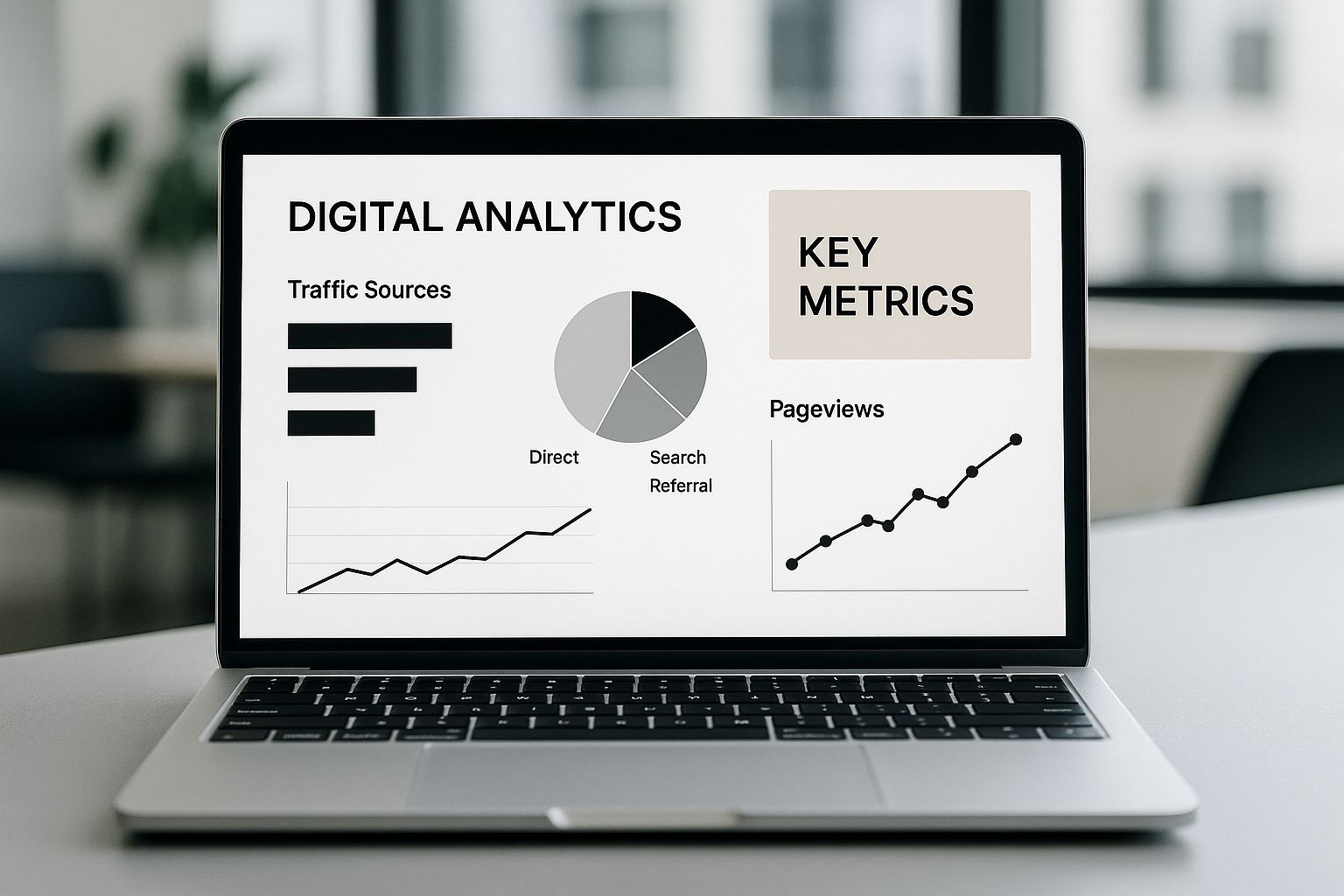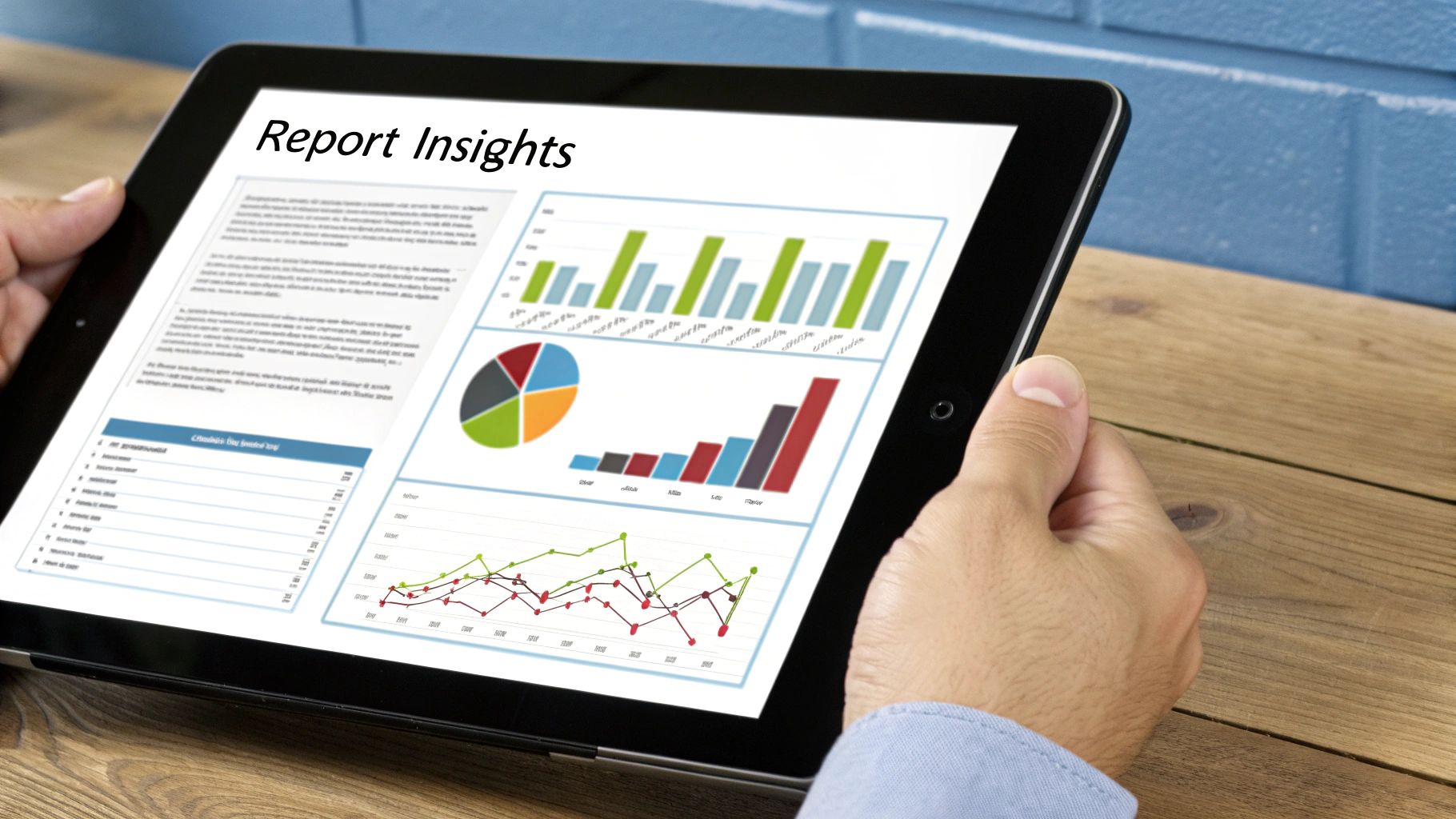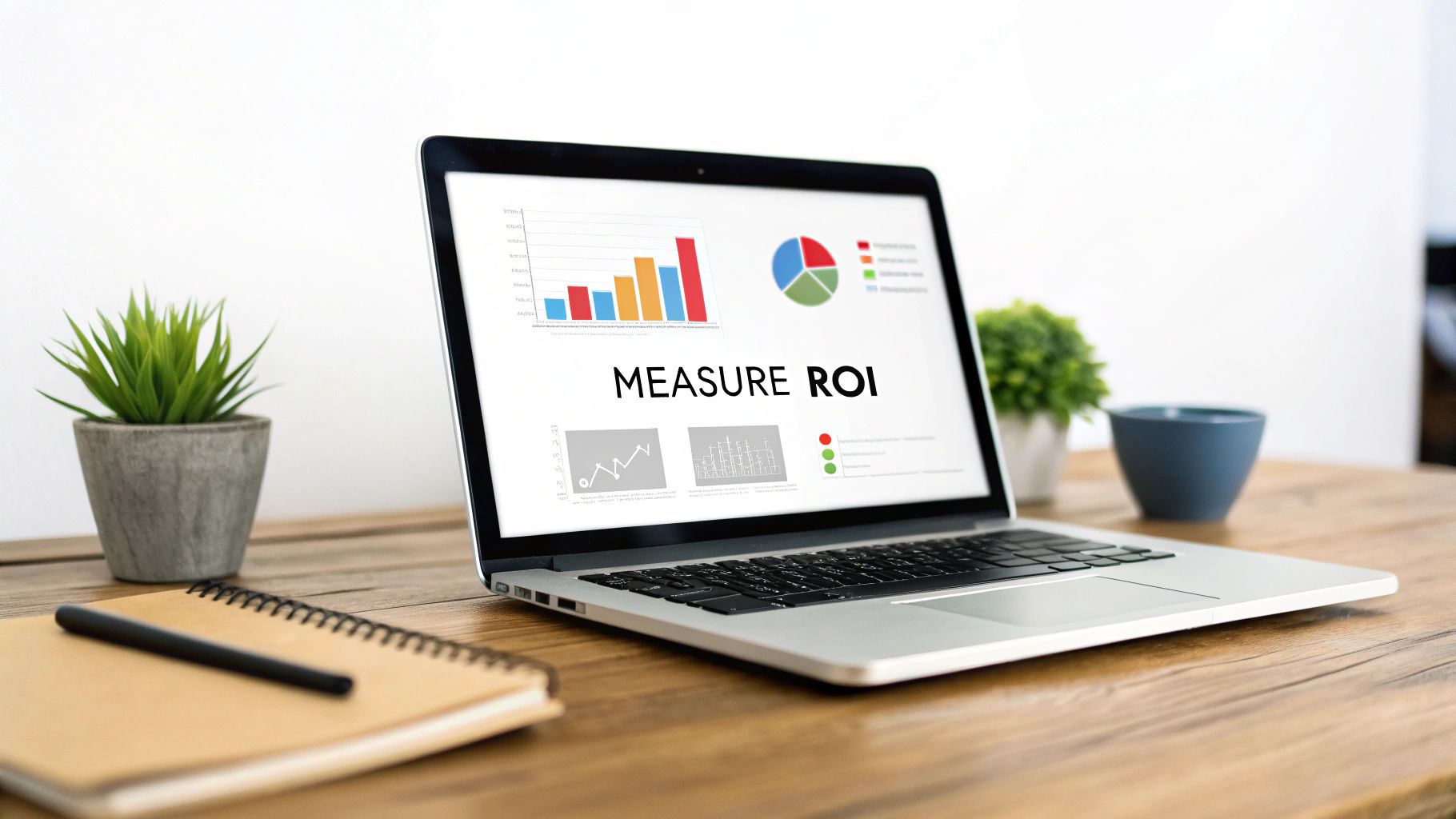Spending money on ads and not knowing if it's working? It’s one of the most common pain points we hear from e-commerce founders. You're pouring cash into Meta, Google, and TikTok, but when you look at your Shopify dashboard, it’s tough to connect the dots. You're not alone. The biggest mistake we see is brands getting lost in vanity metrics—likes, clicks, and shares—instead of focusing on what really matters: profit.
When you can’t prove which marketing activities are driving sales, your budget is always at risk. But when you get it right, marketing becomes your most predictable engine for growth. In this guide, you’ll learn exactly how to measure marketing effectiveness, cut through the noise, and make data-driven decisions that actually grow your bottom line.
What is Marketing Effectiveness? (And What It Isn't)
Let's be direct. Marketing effectiveness isn't about giving 100% of the credit to the last ad a customer clicked. The modern customer journey is messy. Someone might see a TikTok video, get a retargeting ad on Instagram a few days later, and finally buy after receiving a WhatsApp message about their abandoned cart.
Key Takeaway: Effective measurement isn't about finding the one channel that works. It's about understanding how all your marketing touchpoints work together to influence a customer's decision to buy—and keep buying.
This requires a shift in mindset. Instead of obsessing over a single campaign's Return on Ad Spend (ROAS), you need to focus on metrics that tell the complete story:
- Contribution to Pipeline: How are your campaigns generating qualified leads and sales?
- Impact on Customer Lifetime Value (LTV): Are you attracting loyal, repeat customers or one-time discount hunters?
- Blended Profitability: How is your total marketing investment impacting your overall business profitability?
Measuring marketing effectiveness means looking at the entire ecosystem. It's the difference between knowing a single ad's performance and understanding your holistic Marketing Efficiency Ratio (MER). By focusing on the right numbers, you transform marketing from a cost center into a predictable revenue driver. A crucial first step is learning how to calculate your marketing ROI correctly, as it provides the foundation for all deeper analysis.
The Only KPIs That Actually Matter for E-commerce
It’s easy to get buried in data. Dashboards light up with dozens of metrics, and before you know it, you’re tracking things that have zero impact on your bottom line.
From our experience with over 500 Shopify stores, the most successful brands cut through the noise. They don't track everything. Instead, they focus on a handful of key performance indicators (KPIs) that tell them exactly what’s working and what isn’t.
Let’s break down the practical metrics that move the needle. Think of them in three core buckets: how you get customers (Acquisition), how you turn them into buyers (Conversion), and how you keep them coming back (Retention).

Acquisition: Your Customer Magnet Metrics
Acquisition KPIs tell you how effectively you’re attracting new customers and how much it costs to do so. Get this wrong, and you're just burning cash.
- Customer Acquisition Cost (CAC): This is your total cost to acquire one new paying customer. You calculate it by dividing your total marketing and sales spend over a period by the number of new customers you acquired. Your CAC must be lower than your Customer Lifetime Value (LTV) for your business to be profitable. It's that simple.
- Cost Per Acquisition (CPA): This is more specific. CPA tracks the cost for a non-paying action, like a lead magnet download or an email signup. Think of it as a leading indicator for the health of your top-of-funnel activities.
Conversion: The Cha-Ching Metrics
You've got traffic. Now, how good are you at turning those visitors into paying customers? That's what conversion metrics reveal.
- Conversion Rate (CVR): The classic e-commerce metric. It's the percentage of website visitors who complete a purchase. The formula is (Total Orders / Total Sessions) x 100. A common mistake we see is looking at CVR as a single sitewide number. You must segment it by channel to get real insights.
- Average Order Value (AOV): This is the average amount a customer spends in a single transaction. Increasing your AOV with bundles, upsells, or free shipping thresholds is one of the fastest ways to grow revenue without increasing ad spend.
Retention: The Long-Game Metrics
This is where profitable e-commerce businesses are built. It's not about the first sale; it's about the second, third, and beyond. Retention metrics show how effective you are at earning repeat business.
From our experience: It costs five times more to acquire a new customer than it does to retain an existing one. Focusing on retention isn't just a smart move; it's an economic necessity for survival.
The king of retention metrics is Customer Lifetime Value (LTV). LTV predicts the total revenue you can expect from a single customer over their entire relationship with your brand.
It's your north star because it puts everything else into context. A high CAC is perfectly fine if your LTV is significantly higher. To understand what your customers are truly worth, use our free customer lifetime value calculator.
Here’s a quick-reference table of the KPIs every e-commerce marketer should have on their radar.
Essential E-commerce Marketing KPIs
Focusing on these core metrics gives you a clear, actionable snapshot of your business performance, helping you make smarter decisions without getting lost in a sea of data.
How to Build a Tech Stack for Accurate Measurement
Your measurement is only as good as the tools you use. We've seen too many brands make huge budget decisions based on misleading data from a single platform like Meta Ads Manager. It only gives you a tiny piece of the story, not the whole picture.
To truly get a handle on how to measure marketing effectiveness, you need a stack of tools that talk to each other. This is how you connect the dots from the first ad click all the way to a customer's tenth purchase.

The Core Components of Your Measurement Stack
Think of your tech stack like a three-legged stool. Each leg supports a critical part of your data story. If one is shaky, the whole thing falls apart. After working with countless top-performing Shopify stores, this is the setup that consistently provides the clarity they need to scale.
Web & Behavior Analytics (The "What")
This is your foundation. The absolute non-negotiable here is Google Analytics 4 (GA4). This tool tells you what people do on your site—which pages they visit, how long they stay, and where they drop off. GA4 provides the crucial behavioral context for all your other marketing data.
Attribution Platform (The "How")
Here’s where you connect ad spend to actual sales. In a post-iOS 14 world, a dedicated attribution tool like Triple Whale or Northbeam is essential. These platforms stitch together the messy customer journey across multiple touchpoints. They help you understand how different channels work together to drive a conversion, moving beyond the simplistic last-click model.
Owned Channel Platform (The "Why")
This is the most overlooked piece of the puzzle, yet it's often the most valuable. This is where a platform like Kanal excels. Your owned channels, especially WhatsApp, are where you have direct, high-intent conversations with customers. It’s where you discover the why behind their buying decisions.
Integrating Owned Channels for the Full Story
Ignoring your owned channel data is like throwing away feedback from your best customers. Sure, email and SMS have a role, but WhatsApp is in a different league entirely.
With a 98% open rate, WhatsApp conversations are a goldmine for understanding what customers truly want, collecting valuable zero-party data, and boosting LTV. We've seen clients increase their LTV by over 20% by implementing post-purchase flows on WhatsApp.
When you integrate a tool like Kanal—an official Meta Business Partner—with your Shopify store and analytics stack, you unlock a deeper layer of measurement. Suddenly, you can attribute revenue directly to specific WhatsApp campaigns, like an abandoned cart reminder or a post-purchase upsell.
This completes the loop. GA4 shows you a user abandoned their cart. Your attribution tool says they came from a Facebook ad. But Kanal shows you that the WhatsApp reminder you sent an hour later is what actually recovered the sale. You didn't just report a lost sale; you actively recovered that revenue and gave the customer a great experience. This is how you build a measurement system that drives future growth.
Rethinking Attribution in a Privacy-First World
The old days of tracking every user click are over. With iOS updates and growing privacy regulations, the classic last-click attribution model is less reliable than ever. So, how can you confidently measure your marketing effectiveness today?
The brands we see winning have stopped trying to perfectly track every touchpoint. Instead, they're embracing smarter measurement models that don't depend on individual user data.
The Rise of Incrementality Testing
Let's demystify incrementality. In simple terms, incrementality testing answers one crucial question: "Would this sale have happened anyway if I hadn't run this ad?" It isolates the true lift your campaigns are generating.
Think of it like this:
- Standard Attribution: Tells you which channel got credit for the sale.
- Incrementality Testing: Tells you how much of that sale was truly caused by your marketing.
The good news is you don't need a data science team for this anymore. Platforms like Meta and Google have built-in lift study tools. These let you test the real-world impact of your campaigns by comparing an exposed group (who saw your ads) to a control group (who didn't).
The Big Comeback of Media Mix Modeling
Another powerful, privacy-safe approach is Media Mix Modeling (MMM). Instead of tracking individuals, MMM uses aggregated data—like your total ad spend per channel and your total sales—to create a top-down view of what’s driving performance.
Because it doesn't rely on cookies or pixels, it’s completely compliant with privacy regulations. It gives you a holistic view of your entire marketing ecosystem, including offline channels. According to a report from Nielsen, 61% of marketers plan to enhance their measurement strategy with MMM as privacy restrictions tighten.
The strategy that consistently delivers the best results for our clients is a blend. They use platform attribution for daily optimizations but layer in insights from incrementality tests and MMM to make smarter, high-level budget decisions. This approach helps you understand the full story, a key part of learning how to create a customer journey map that reflects today's reality.
Turning Data Into Smarter Marketing Decisions
Collecting data is one thing; turning it into revenue is the real goal. All the dashboards in the world are useless if you don't use them to make smarter, faster decisions. This is where you move from just reporting on what happened to actively shaping what happens next.
From our work with top e-commerce brands, the magic happens when you build a consistent process for reviewing performance. It’s about looking at the numbers and asking the tough questions. Which channels are really driving profitable growth? Are we attracting high-LTV customers? Where are the hidden leaks in our funnel?

From Insight to Actionable Strategy
Acting on data means you have to be willing to challenge your own assumptions. It's easy to get attached to a channel because it "feels" right, but the numbers often tell a different story.
A practical first step is to set up a regular performance review. It doesn't have to be complicated. Just set a weekly or bi-weekly meeting to look at your core KPIs and spot the outliers.
- Find Your Winners: Identify the campaigns or channels with the highest ROAS and lowest CAC. Double down on what's working.
- Diagnose Your Losers: If a campaign is tanking, don't just kill it. Dig deeper. Is it the creative? The audience? The landing page experience?
- Segment Your Customers: Look at which campaigns are bringing in customers with the highest AOV and repeat purchase rates. These are your golden cohorts.
A Real-World Example From The Trenches
Here's a real-world example from a brand we work with. A D2C apparel brand was running post-purchase upsell campaigns on both email and WhatsApp. On the surface, their email campaigns had a higher click-through rate, so they put most of their retention budget there.
But when they analyzed their campaign data directly within the Kanal dashboard, they discovered something huge: the post-purchase upsell flow sent via WhatsApp was generating a 25% higher AOV than the email version. Customers weren't just converting; they were spending significantly more.
This single data point changed their entire strategy.
They immediately reallocated a larger portion of their retention budget to their WhatsApp flows. The result? A significant lift in overall profitability without spending a single extra dollar on acquisition.
This is a perfect example of how getting granular data on how to measure customer engagement on your owned channels can reveal massive, hidden opportunities. This is the heart of effective marketing measurement—using precise insights to make every dollar you spend work harder.
FAQs on Measuring Marketing Performance
We get it. Measuring marketing can feel like hitting a moving target. Here are straight answers to the questions we hear constantly from brands in the trenches, focused on the practical side of how to measure marketing effectiveness.
How often should I check my marketing metrics?
It depends on the metric. Here’s a simple framework:
- Daily Pulse Checks (5-10 minutes): A quick morning check-in on ad spend, traffic, and sales. You're just looking for red flags, like a sudden drop that could signal a broken link or a disapproved ad.
- Weekly Performance Dives (30-60 minutes): This is where you dig into campaign performance. Review your ROAS, CAC, and AOV by channel. A common mistake we see is letting a bad ad set bleed cash for weeks. This weekly check-in prevents that.
- Monthly & Quarterly Strategy Sessions: Now you zoom out. Review your LTV:CAC ratio and cohort performance to make bigger budget allocation decisions. This is how you determine if a channel is truly profitable long-term.
What’s a good ROAS for an e-commerce brand?
The only real answer is: it depends on your profit margins. People love to throw around 4:1 ROAS ($4 in revenue for every $1 spent) as a benchmark, but that number can be very misleading.
If your product has a 70% margin, a 3:1 ROAS might be incredibly profitable. But if your margin is 25%, that same 3:1 ROAS could mean you're actually losing money after factoring in COGS, shipping, and other expenses.
The better question is, "What's my break-even ROAS?" Once you know the absolute minimum you need to break even, you can set profitability targets that actually make sense for your business.
How do I measure my WhatsApp marketing campaigns?
This is more straightforward than you think if you use the right tool. With a platform like Kanal, measurement is built-in. Every campaign you run, from cart recovery to a VIP sale, comes with direct revenue attribution.
You can track the most important metrics right from your dashboard:
- Revenue Generated: See the exact dollar amount each WhatsApp automation brings in.
- Conversion Rate: Understand which messages and offers compel people to buy.
- AOV per Campaign: Pinpoint which campaigns encourage customers to spend more.
As an official Meta Business Partner, Kanal gives you the tools to see exactly how your WhatsApp conversations translate into sales, turning it into a measurable revenue driver.
My ad platform data doesn't match Google Analytics. What should I do?
First, don't panic. This is the most common frustration for marketers. It's normal for these numbers to differ because they measure things differently.
- Meta Ads Manager reports on both views and clicks within its own ecosystem.
- Google Analytics typically uses a "last non-direct click" model focused on what happens during a website session.
The strategy that consistently provides clarity for our clients is to use a third-party attribution tool like Triple Whale as your "single source of truth." These tools are designed to pull data from all your platforms and stitch it together, giving you a much more holistic and reliable picture of what’s actually driving sales.
Key Takeaways
- Focus on Profit, Not Vanity: Ditch metrics like likes and shares. Prioritize CAC, LTV, AOV, and Conversion Rate to understand true business impact.
- Build a Modern Tech Stack: Your measurement is only as good as your tools. Combine GA4 (the "what"), an attribution tool like Triple Whale (the "how"), and an owned channel platform like Kanal (the "why").
- Embrace Modern Attribution: Last-click is dead. Use incrementality testing and Media Mix Modeling to understand the true lift of your marketing in a privacy-first world.
- Turn Insights into Action: Don't just collect data—use it. Set up regular performance reviews to double down on what works, diagnose what doesn’t, and make smarter budget decisions.
Ready to stop guessing and start measuring? See how Kanal can turn your WhatsApp channel into a predictable, high-ROI profit center. Install Kanal on your Shopify store today.



